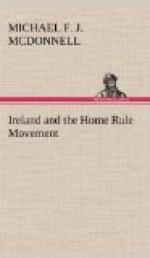The contrast between the history of Great Britain and that of Ireland during the last century—in the one case showing progress and prosperity, advancing, it is not too much to say, by leaps and bounds, and in the other a stagnation which was relatively, if not absolutely, retrograde—is one of the most dismal factors in English politics. Those who would explain it by natural, racial, or religious considerations are probing too deep for an explanation which is in reality much closer at hand. If the external forces in the two countries throughout that period had been the same it would be right and proper to search for an explanation in such directions as have been named, but that these forces have not been so distributed it is my contention to prove.
The closing years of the eighteenth century in Ireland, coinciding as they did with the achievement of Parliamentary independence, witnessed in that country a remarkable growth of national prosperity. Up to the year 1795 the taxation of the country never exceeded one and a half millions of pounds, and the National Debt was not more than one million. In the succeeding years the French war and the rebellion of ’98 swelled the expenditure, as did the maintenance of an armed force in the country, which was the corollary of the rebellion, and that process which Lord Cornwallis, the Lord Lieutenant, described as “courting those whom he longed to kick,” by which the Act of Union was passed, added another million and a half to the national expenditure.
The result of the various causes was that in the year 1799-1800 the taxation of the country had risen to three millions, and the National Debt amounted to just under four millions of pounds.
It is necessary to enter into these details, because it was on the basis of the years 1799-1800, and not on that of a year of normal expenditure, such as was 1795, that Pitt and Castlereagh framed the financial clauses of the Act of Union, which were to establish the taxable relations between Great Britain and Ireland.
Having said so much we need not pause to consider how far the financial clauses were justified. It will suffice to say that they provided that Ireland should pay two-seventeenths of the joint expenditure of the United Kingdom, together with the annual charge upon her pre-union debt. One should add, however, that the Irish House of Lords protested that the relative taxable capacities of Ireland and England did not bear to each other the ratio which the Act enunciated of 1 to 7-1/2, but in reality of 1 to 18.
It was no part of Pitt’s scheme that there should be fiscal union. A separate Irish Chancellor of the Exchequer, drawing up an Irish budget and regulating an Irish debt, remained after the union of the legislatures. Speaking in 1800 on this very point Lord Castlereagh declared that:—
“It must be evident to every man that if our manufactures keep pace in advancement for the next twenty years with the progress they have made in the last twenty, they may at the expiration of it be fully able to cope with the British, and that the two kingdoms may be safely left like any two countries of the same kingdom to a free competition.”




